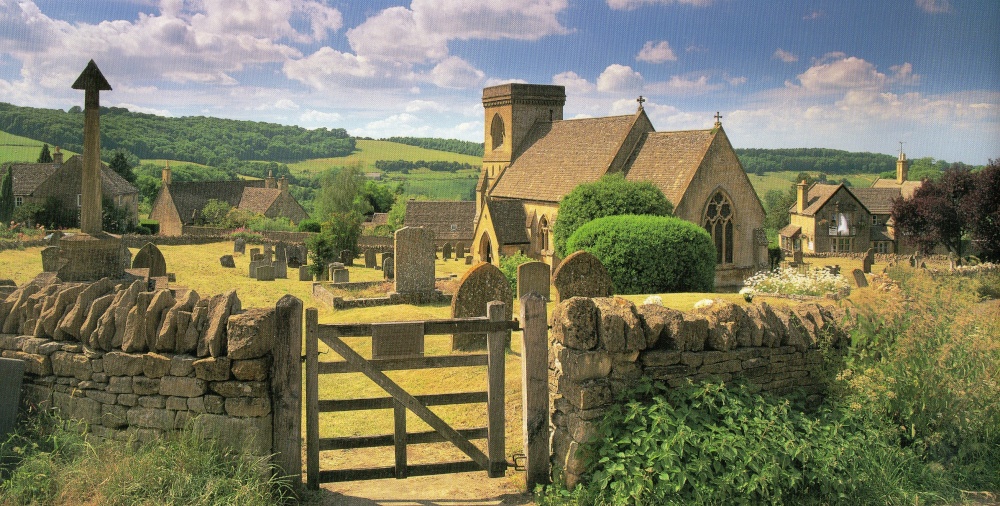
Snowshill Parish Church - Image by PicturesOfEngland.com member David Reynolds (view gallery)
The Cotswolds is a region of England that is famed the world over for its beautiful rolling countryside and its ancient little villages and towns that once prospered from the wool trade, enabling them to build some of the finest buildings and churches in the whole of Britain. One of its special features is that most of the buildings throughout the region are built using the beautiful honey-coloured limestone unique to the area, making everything exude a warmth and charm unlike anywhere else, and which adds to its picture-perfect appearence - from its stone walls and ancient bridges throughout the countryside, to the cosy cottages and other buildings that make up the villages and towns, including the many stunning market places, town halls and beautiful churches, it all has a warm golden hue, which along with the green backdrop of the surrounding beautiful countryside creates an idyllic fairy-tale like setting that attracts visitors from all corners of the world who come to experience its unique beauty.
Here we list 10 of the best places you can visit in the Cotswolds, with links to more information and pictures of each place, including links to other similar articles and lists that help you learn more about beautiful England and what it has to offer.
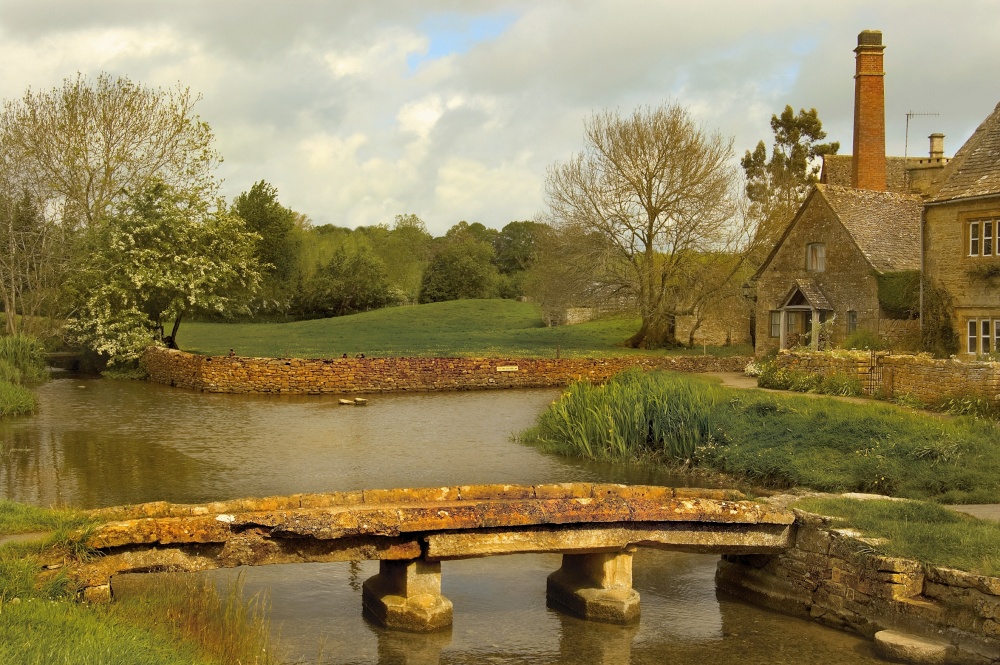
Footbridge - Image by PicturesOfEngland.com member Ken Brazier (view gallery)
Lower Slaughter is one of the Cotswold's most idyllic villages where you should abandon your car and roam around on foot. It perfectly epitomises the very best of tranquil English villages, having the notable attributes of peaceful flowing waters, a lovely old mill, gorgeous stone cottages, a splendid church and two beautiful 17th century country houses now converted into luxurious country house hotels.
The gentle waters of the River Eye flow slowly beneath narrow footbridges. The Old Mill, with its restored water-wheel acts as a magnet to visitors, it has undergone recent refurbishment and offers a museum, craft shop and tea-room.
Perhaps the most notable feature of the village is its lovely church dedicated to St.Mary. Here, on a walk around the church visitors gaze in wonder at its ancient spire, rich adornments to its beautiful stone walls, and inside you are bewitched by the dazzling rays of light falling through stunning stained glass windows. There are glorious carved stone arches, glowing woodwork, a memorable font, and many other church treasures in this peaceful place which is worth looking around and spending a few moments in quiet contemplation.
Lower Slaughter Manor is Grade II listed, it is now a hotel set in beautiful grounds where you will find an attractive walled garden. Washbourne Court is set at the side of the River Eye, this too is now a hotel. Both these wonderful old places typify the gracious, romantic era in which they were first built over 300 years ago. Like the rest of the village, these buildings look gorgeous when dappled by the fading light of a setting sun.
ID#70
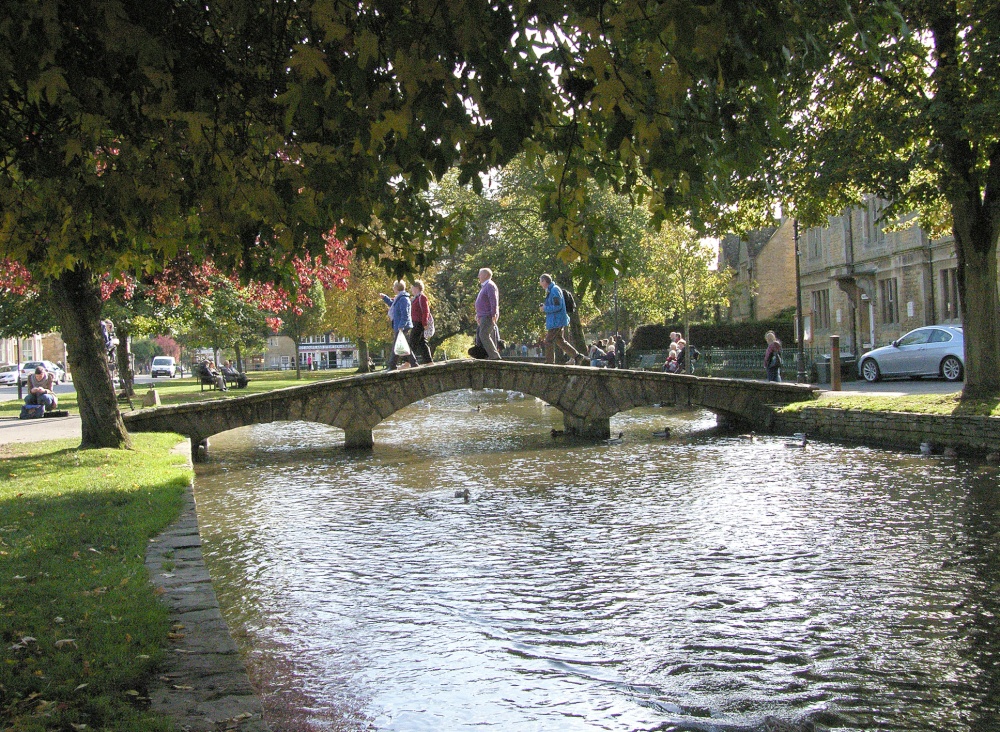
Bourton on the Water - Image by PicturesOfEngland.com member Brian Ireland (view gallery)
Bourton on the Water is a beautiful Cotswold village often referred to as ‘The Venice of the Cotswolds’ or ‘Little Venice’ as it center’s around the river Windrush, a focal point for visitors who on summer days relax either side of its shallow slow-flowing waters, taking in the Cotswold air and beautiful view whilst enjoying a locally made ice-cream or perhaps a picnic.
The river is crossed by small stone ancient footbridges allowing you to cross its shimmering waters, from which resident ducks swim curiously by, and on warmer days children paddle, braving their feet and ankles into the cooling clear waters, where sometimes too dogs will playfully splash around. It really is a beautiful place to relax and enjoy with plenty to see and do there as you wonder around on foot enjoying this perfect Cotswold village setting.
Attractions in the village include the wonderful model village which is open all year round and is an exact replica of the village but everything is waist high. It even has the river running through it, a replica of the village church, streets and houses and it is all beautifully crafted and fascinating to see.
Birdland is another popular Bourton attraction, opened in 1957 there are many beautiful and exotic birds to be seen including the popular penguins and flamingos.
For anyone with an interest in cars, including toys and memorabilia, then the Cotswold Motoring Museum is a must visit with its fantastic collections including classic cars, motorbikes and caravans.
ID#28
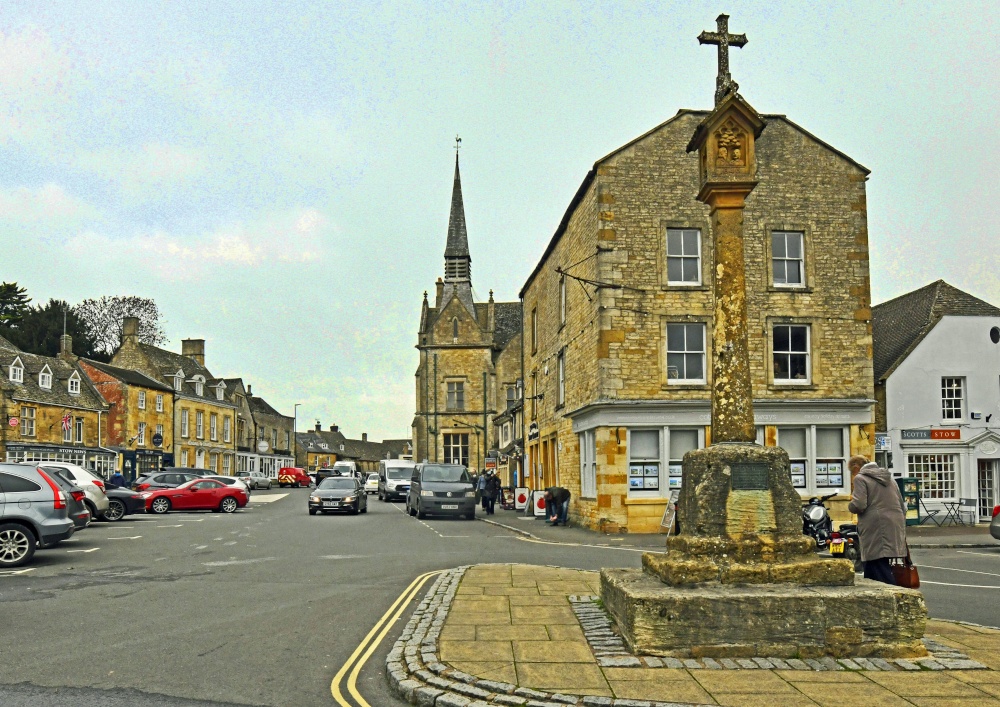
Stow on the Wold - Image by PicturesOfEngland.com member Paul V. A. Johnson (view gallery)
Welcome to "Stow on the Wold, where the wind blows cold" - an old saying because of Stow being situated at the high point of the Cotswolds, 800 feet above sea level. Stow is a beautiful town, and probably the busiest of all the cotswold towns. Infact if you judge it by the size of its market square, this shows that it has always been a busy part of the cotswolds. Many years ago when the cotswold wool industry was at it's height, Stow was famous for it's huge annual fairs where as many as 20,000 sheep were sold at a time at the busy market square. The square is now mainly used for parking, as Stow is a favourite destination for many a visitor to the Cotswolds.
With its beautiful streets and buildings, and interesting shops, Stow is a great place to base yourself if you plan on visiting the area and exploring the Cotswolds further, as it has eight roads intersecting and is often refered to as the very heart of the Cotswolds. With its wonderful church, rich history and beautiful town, Stow on the Wold is one of the perfect English towns that remains a must visit in most tourist guides of England.
ID#72
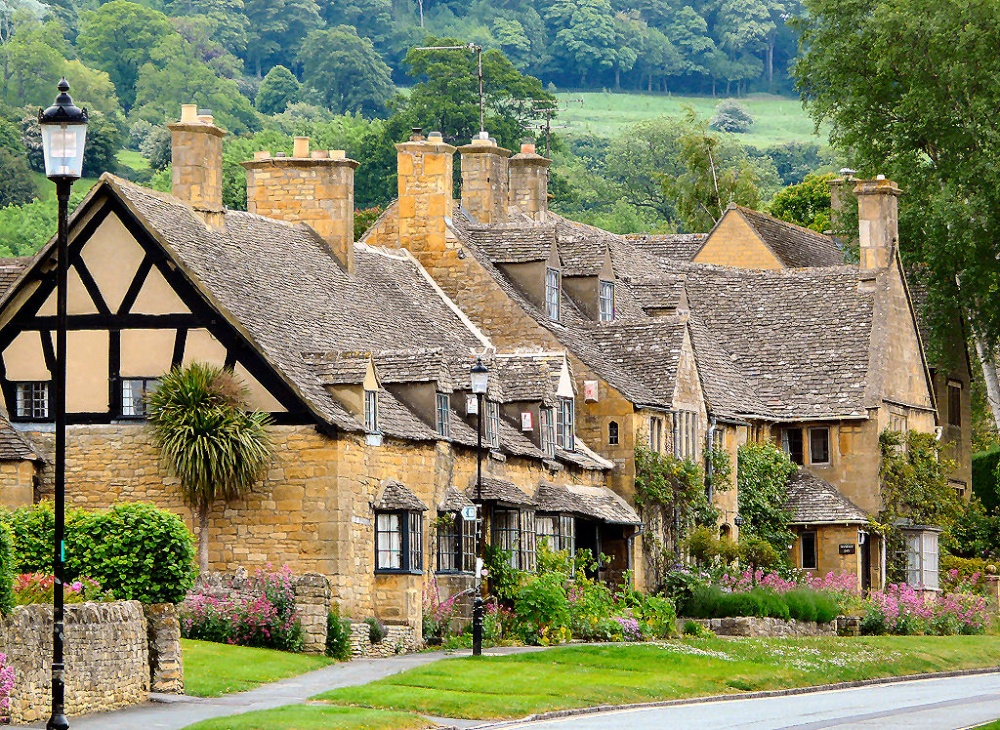
Broadway, Worcestershire - Image by PicturesOfEngland.com member Kevin Tebbutt (view gallery)
Immediately appealing with its wide main street and gracious houses, Broadway richly deserves the prestige of being the "show village of England".
All built of honey coloured Cotswold stone, houses and cottages ramble hap-hazardly along pleasant green-verged roads. Steep gables of the larger houses rise high above the roofline of the dormer-windowed cottages and here and there black and white thatched roof cottages help to soften the bluffness of weathered stone dwellings.
The centre of the village is dominated by a famous hotel. Much loved by visitors from all over the world (and locals alike) the Lygon Arms has its origins rooted deep in the 16th century. To-day, most luxurious and hospitable of hotels, retains all the charm of the great private house it once was. Famous past visitors include Charles 1 and Oliver Cromwell both of whom stayed here at different times.
One of the villages most famous residents was Gordon Russell who began his career restoring furniture for the Lygon Arms in 1904.
Mr. Russell went on to found a business in hand made furniture and today many of his pieces, when up for sale in local auction rooms, fetch excellent prices.
Broadways High Street stretches for almost a mile before rising sharply at Fish Hill. The Fish Inn, situated to the top of the hill is reputed to be 800ft above sea level. This building was originally a summer house, built on the estate of a local landowner in the 18th century and imaginatively, it has a sun-dial set into its roof. Travel further along and the ground rises to more than 1,000ft where the areas crowning glory and one of the best known landmarks of the Midlands is built - Broadway Tower. This tower was built in 1800 as a folly for the Earl of Coventry who was delighted at the fact that he could view the folly from his family seat at Worcester, some 20 miles away. To-day, folk visit this Tower to enjoy the magnificent views of the gentle rolling countryside that surrounds it.
There are two parish churches in Broadway, St. Michaels was built during the 1830's is situated close to the village green and the other is the old church of St.Eadburgha which dates back to the 12th century.
Boadway is a pleasant place to visit at any time of year. The main street is littered with quaint craft and gift shops and well as art galleries and antique shops. There is also a very small shopping precinct in which you will find a lively deli which sells a wide range of delicious foodstuffs. In summertime a marquee is errected on the village green for the local fruit and flower show. Ice-cream is sold in the street by vendors dressed in Victorian costume, and often there are dancing displays by Morris dancers. In winter there is the colourful and attractive sight of the local Hunt leaving for a days sport from outside the Lygon Arms.
There are a wealth of old country inns and pleasant cafes in which to enjoy a tastly meal or just while away a pleasant hour and whilst all of this adds to the natural charm of this so very English of English country villages it is easy to understand just why folk return here year after year. For not only is Broadway very atmospheric it is also a very addictive place indeed.
ID#34
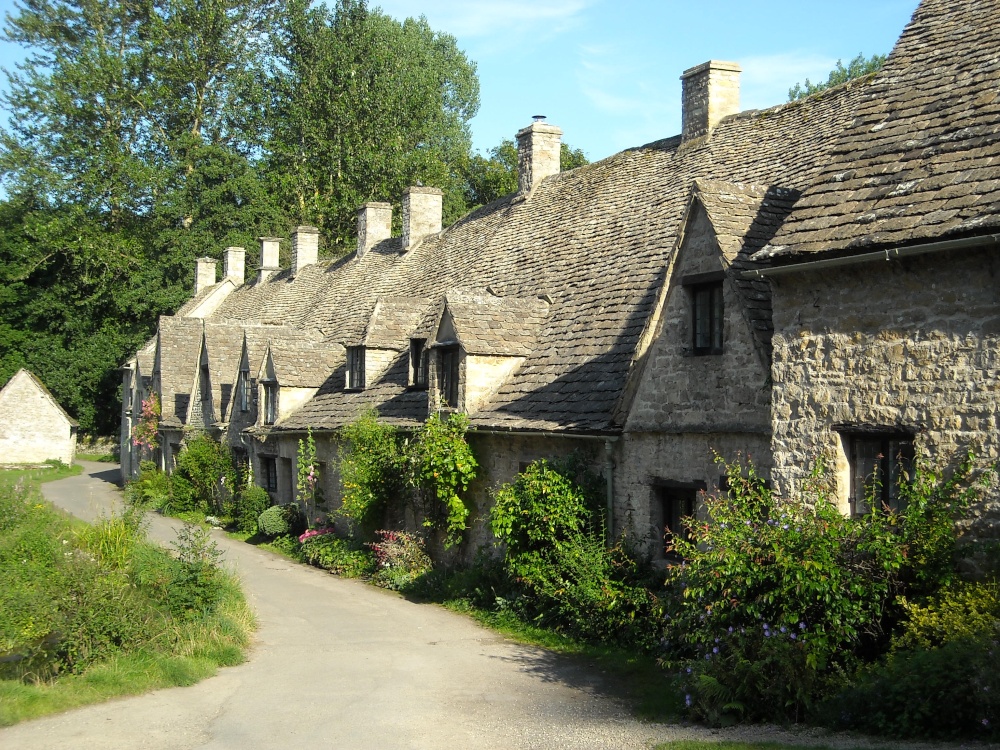
Bibury - Image by PicturesOfEngland.com member Martin Humphreys (view gallery)
William Morris, the 19th-century artist and poet thought Bibury to be the most beautiful village in England. This sentiment was echoed by another Victorian, J. Arthur Gibbs, wrote of it elequently in A Cotswold Village, published in 1898.
The slow moving River Coln wends its way between wooded banks and is spanned by a road bridge dated 1790. Many of the stone-built houses have gardens than run down to meet this sparkling river, and on the banks of the mill stream which flows into the Coln, stands a terrace of gabled and stone-tiled cottages called Arlington Row. The cottages were converted from a 14th-century sheephouse in the early 17th-century to provide housing for weavers supplying cloth for the nearby Arlington Mill. These cottages are now owned by the National Trust and Arlington Mill is now a museum and houses a fine collection of furniture from the Cotswold Arts and Crafts movement.
There is a rich variance of properties in Bibury, some are of timber frame with thatched roofs, but mostly they are built of Honey coloured Cotswold stone, having steep gables and tall chimneys, often with delightful small stone clad windows and nearly all submerged in seemingly motionless green foilage. It is these wonderful houses, so traditional of the Cotswolds, that causes Bibury to be thronged with an endless stream of visitors throughout, not only high summer but all the year round.
The centre of Bibury is the square, overlooked by the Saxon Church of St. Mary. St. Mary's has many later additions, mostly Norman and Medieval, but much of the Saxon work is still visible.
Bibury Court is of Jacobean origin and The Swan is a pleasant early coaching inn. There are several other inns and public houses
both in and around the village.
This is an enchanting village and well worth a visit for it is a village that possesses the dream-like quality of a Christmas card.
For further information, please visit: www.bibury.com
ID#296
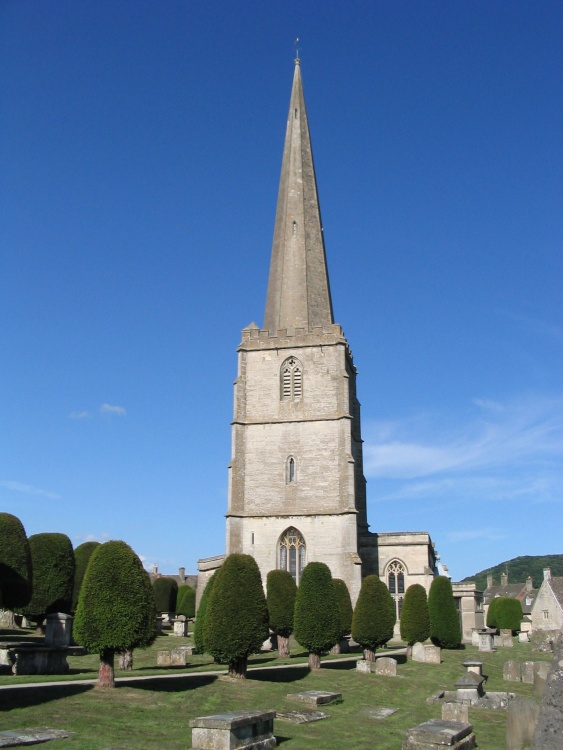
Painswick - St. Mary's Church and Yard and Yew Trees - June, 2003 - Image by PicturesOfEngland.com member Judith Hays (view gallery)
Many centuries ago the delightful town of Painswick was at the centre of the 'Wool' industry and this is evidenced by the numerous grand old houses and inns, many of which were built by the wealthy wool merchants who settled in the town.
The streets of Painswick are narrow and crammed with fine examples of glowing honey coloured stone buildings from all periods. The most notable street, is New Street, built during the heady days of the wool trade when the townsfolk of Painswick prospered from the stability induced by good trading conditions. New Street also has the only half timbered building to be seen in Painswick.
St. Mary's parish church has an imposing tower, The church is thought to date from Norman times but was embellished during the 15th-century through the gifts of rich wool merchants. It is a beautiful church that contains many ancient reminders of the towns historic past. The 99 great Yew Trees in the churchyard are as overwhelming as they are beautiful and legend tells that should a hundreth tree be planted, it would be shrivelled by the devil. Most of the tombs in the churchyard date medieval times, they provide the last resting place for many rich wool merchants and their families.
This town is all quiet elegance and quaint charm, one charming place is the Falcon Inn which has an immaculately manicured bowling green. This green is an engaging sight in the summertime when teams of ladies and gentlemen, dressed traditionally in white, engage in the art of the ancient game of bowls. There are other properties dating from the 14th-century and the tall chimneyed Court-House is associated with King Charles I.
The famous Rococo Gardens are a feature of Painswick House on the edge of the town. The manor is surrounded by several acres of gardens set to this design in the days when Rococo style was fashionable. The gardens are a rare pleasure and worth taking the time to stroll round.
Painswick lies at high altitude but higher still is Painswick Beacon which affords excellent views of the magnificent Severn Valley and the clusters of nearby Cotswold towns and villages that inhabit the beautiful surrounding countryside. It is a place to relax and enjoy, and from which you will take many memories.
ID#496
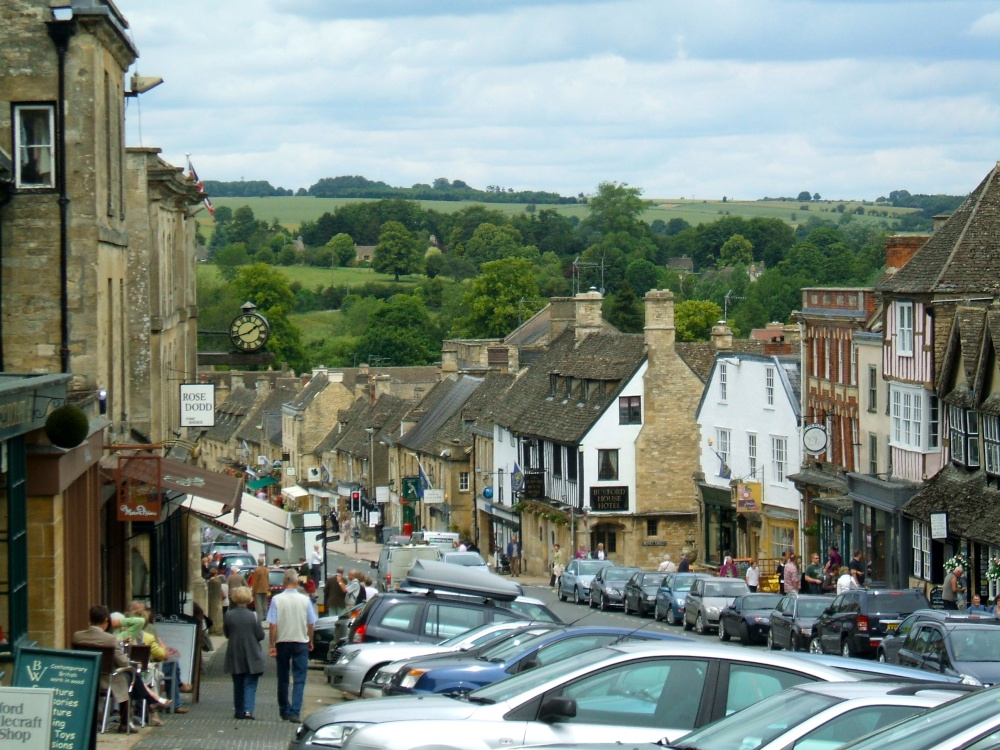
A busy day - Image by PicturesOfEngland.com member John Love (view gallery)
Burford is an attractive Cotswold town in the Oxfordshire part of the Cotswolds, with a famous High Street that slopes down to a three-arched medieval bridge that carries traffic across the river Windrush.
Once a thriving wool town, Burford has some beautiful buildings including the grand Church of St John the Baptist, which is a Grade 1 listed building. This church was used as a prison in 1649 during the Civil War, and some of the prisoners graffiti carvings still survive today.
The Tolsey, along Burford's High Street is now the town museum but was once a place for trade, and dates back to the 16th century, being first documented in 1561.
ID#35
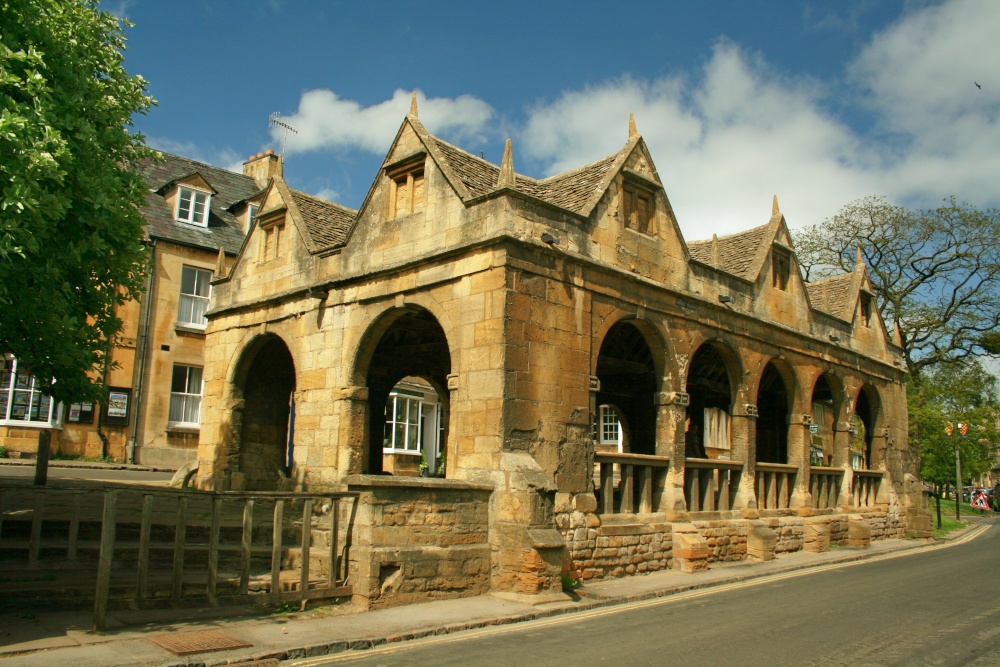
The Market Hall - Image by PicturesOfEngland.com member Adie Ray (view gallery)
Immediately appealing, this is certainly one of the most picturesque small towns in the northern reaches of the Cotswolds. The town bears all the hallmarks of the 14th and 15th-centuries when it was an important wool town and the wealthy merchants brought their fleeces to do trade at the exquisite 14th-century Woolstaplers Hall.
William Grevel was a wool merchant who gave generously to the town and the church. His house is one of Chipping Camden's special blessings, it has a beautiful two storey carved bay window dating from the 14th-century. The house can be found in the main street, opposite the Woolstaplers Hall. Take time to stroll a little further along the street and you will come to Chipping Campdens ancient Market Hall, built in the year 1627 where if you peer from beneath it's mellow stone arches you will glimpse a scene that has changed little since medieval times - such is the lure of this gracious little town.
Historically, Old Campden House, one of the grandest houses in the town was burned down at the time of the Civil War by the Royalists to prevent it falling to Cromwell. Not much remained and the stable block was converted into the Dower House after the Civil War came to an end.
The church of St. James is an imposing church. Its perpendicular tower rises majestically above the town to a height of 120ft. It is without doubt one of the finest 'wool churches' in the Cotswolds, it is mainly of the 15th-century but the chancel belongs to the 14th-century. The church houses many treasures which include a 15th-century brass lectern and several 16th-century monuments, one by Joshua Marshall. There are several brasses, one dedicated to William Grevel, describes him as 'The flower of the wool merchants of England' such was the appreciation of the townsfolk to this man for his extreme generosity. The church has a magical atmosphere and visitors will find it a constant source of fascination. It is well worth a visit.
Strewn along the pavement are perfect examples of gracious mellow stone properties all melting gently together and looking very much as if time had passed them by. Some, cover three storey's and are beautifully gabled with fine stone mullion windows, while others are two storey with enchanting bay windows and one or two have decorative canopied doorways. Some of these buildings are now shops and a wander inside reveals old beams, low ceilings and ever creaking old oak floors.
Chipping Campden has several old inns that have interesting histories and date from the 17th and 18th-centuries. A 17th-century tradition that is carried on in the town is Dovers Games - a re-creation of the classical Olympic Games, held annually in the week following Whit Monday.
This is a town from which you will take many pleasant memories, especially the vision of the ancient main street seen from the well worn stone flags of the beautifully arched Market House.
ID#314
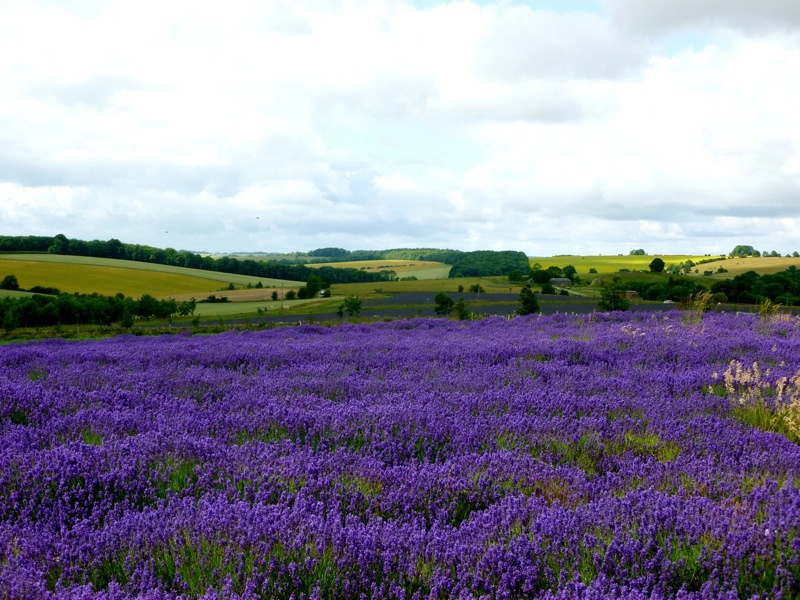
Snowshill Lavender fields. - Image by PicturesOfEngland.com member Kip Bennett (view gallery)
For anyone looking for a peaceful retreat in which to spend a few idyllic days in glorious countryside, could do no better that visit the picturesque village of Snowshill, high on the Cotswold escarpment above Broadway and the old town of Evesham. It lies in a sheltered position, surrounded by fields of fragrant, vibrant lavender, and rich meadows full of lazy cattle and frisky lambs
Snowshill is the home of the famous manor house, now in possession of the National trust, which was formerly the home of Charles Paget Wade, an eccentric craftsman of the 20th century. The manor dates from between the 15th and 16th century. In historic terms the manor was once owned by Winchcombe Abbey, following the Dissolution it passed to the Crown and was later given by Henry VIII to Katherine Parr. Over the following centuries the ownership of the manor fluctuated between many owners and tenants, until in 1919 when it was bought by Charles Paget Wade. By this time it was little more than a shell like building, but Wade, enchanted with the setting of the house, saw immediately its huge possibilities, thus he set about lovingly restoring it back to its former glory.
Wade was a versatile man, he was a trained architect and craftsman who had inherited a fortune from his father's Sugar plantation in the West Indies. He loved the manor, it gave him the perfect place for displaying the huge amount of artefacts he had collected over the years and he spent many happy house arranging and re-arranging his prize possessions. He also laid out the magnificent gardens, these had been left untended for decades. Interestingly, it seems Wade preferred to live in the Priests house in the Courtyard, rather than the manor itself. In 1951, Charles Wade passed the manor with its bewildering collection of antiquities, to the National Trust, both house and the garden are open to the public, they give a charming glimpse of the life of yester-year and make a very worthwhile visit.
At certain times of the year the lavender fields of Snowshill Lavender Farm rival any of those to be seen in Provence. They are exquisite, with line after line of perfectly formed plants in every shade of purple filling the air with their powerful aroma. The farm provides visitors with the opportunity to purchase the plants and to visit its retail outlet and restaurant. In the shop you will discover a vast array of goods, including lavender based toiletries and perfume.
The village church is from the 19th century with parts of the previous church incorporated into the building. It is not as stunning as some of the more famous Cotswold "Wool" churches, but is worth a wander. If you have the time, take a glance around the churchyard, this contains the burial place of Charles Paget Wade.
Snowshill is an attractive village, its homes are all built of mellow, glowing Cotswold stone, all beautifully positioned around the village and dotted amongst the adjacent richly wooded countryside. After a stroll, why not call in to the hospitable Snowshill Arms Pub, here you can enjoy a refreshing drink and tasty meals.
This is an ideal place from which to explore surrounding Cotswold towns and villages, Broadway with its famous tower is within easy reach, also Upper and Lower Slaughter, and Stow-on-the-Wold.
ID#22732
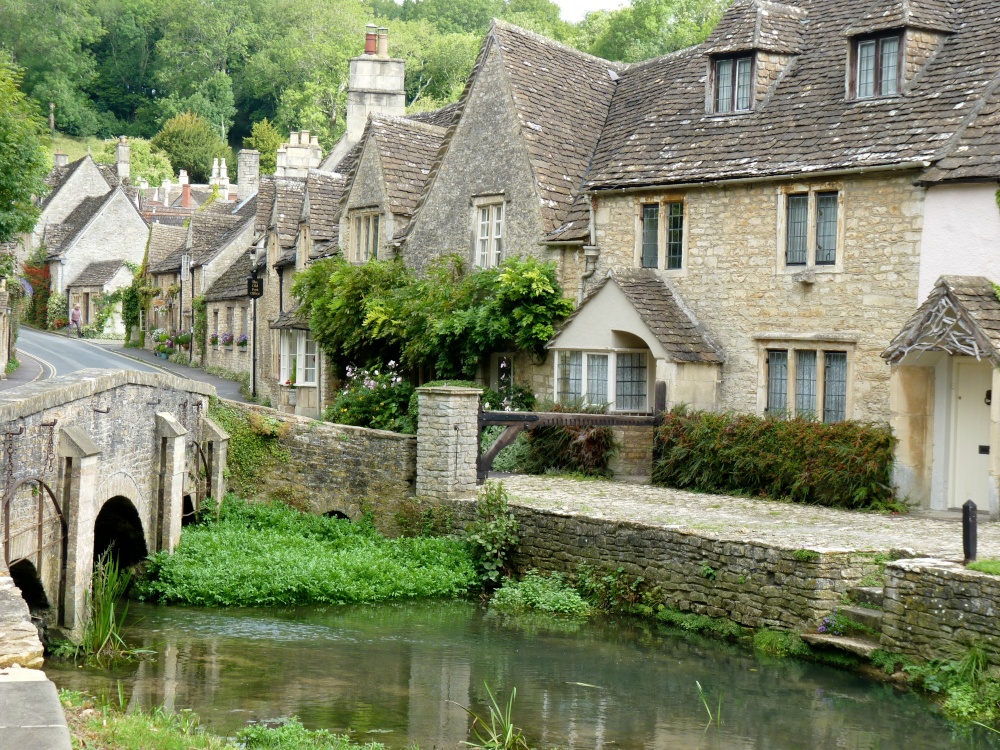
The Classic View - Image by PicturesOfEngland.com member Vince Hawthorn (view gallery)
Often cited as 'the most picturesque village in all of England', this award-winning place is one of the jewels in England's crown and one of the highlights of any visit to England. The village is situated on the southern edge of the Cotswolds, in a valley, and found its wealth in the wool trade with the villages picturesque river 'ByBrook' powering the mills. Visitors to the village can park at the top of the hill and wonder down into the village where they can enjoy walking round this lovely fairytale-like setting. Most buildings are made of the typical Cotswold limestone with its manor being built of the stone from the Norman castle that once sat above the village.
In its center is the 14th century Market Cross with old water pump beside it. The best view is said to be from by the old weavers cottage across the bridge.
The village has its own small museum containing local artifacts, old photos and maps, and a look at the history of the village and surrounding area.
ID#313

| Article Title | Author | Date |
| The Prettiest Streets in England | poe | 24th November 2020 |
| 10 of the best villages to visit in the Peak District, England | poe | 28th July 2020 |
| A look at some of the most famous views in England... | poe | 16th May 2020 |
| THE TRIAL OF THE PYX | Paul V. A. Johnson | 19th August 2019 |
| The Best Sandy Beaches in Dorset | poe | 7th June 2016 |
| 20 Of The Best Market Towns In England | poe | 1st June 2016 |
| A Human Heart and a Ghost Story in a Northamptonshire Church | Charles Moorhen | 30th October 2009 |
| Exploring the English Village Churchyard | Charles Moorhen | 29th October 2009 |
| Local Legends - The Basingstoke Burial | poe | 28th February 2008 |
| The Hidden Churches of Somerset | Louise Simmons | 6th February 2008 |